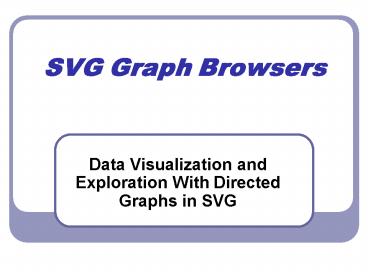SVG Graph Browsers PowerPoint PPT Presentation
1 / 11
Title: SVG Graph Browsers
1
SVG Graph Browsers
- Data Visualization and Exploration With Directed
Graphs in SVG
2
The Challenges
- Need to cope with large amounts of data
- Need for systematic controls on business or
project procedures - Need to author relationship documents of various
types - Desire for a minimum set of simple interface
mechanisms to accomplish as many goals as possible
3
Node-Edge Graph
- Node
- Representative of an entity or process
- Depicted as an icon or shape
- Edge
- Representative of a relationship between entities
or processes - Depicted as a line between Nodes
- Might be weighted or directional
- Can represent complex relationships of data that
cannot be depicted in a tree
4
Types of Data Sources
- RDF
- Given the subject-predicate-object nature of RDF,
this is an ideal match for graphs - Demands an directed graph
- XML
- Can be bi-directional
- Must establish a strict schema to show
relationships - Not always ideal for all XML domains
- Tree structure not always very rich
- SQL
- Must represent dependencies between tables/rows
- Typically, an entity will be a row, and an edge
will be an external key, but it will not always
be so easy with complex datatypes - Easiest if parsed into an intermediary format,
such as RDF or XML
5
Layout and Distribution Strategies
- Traditional graph layouts seek to avoid overlap
of nodes or edges - Spring layout
- Tree/hierarchical layout
- Customized layouts based on novel features
- Clustering
- types of nodes
- relationships between nodes
- Emphasis or hiding of nodes
- Mathematical Idea vs. Pragmatism
- Purity must be compromised in order to achieve
clarity and simplicity of presentation
6
Node Properties
- Wide variety of entities to depict
- Shapes
- Uniform shape (all circles or squares)
- Traditional flowchart or org chart symbols
- Often contain text
- True Representation
- Pictures, Text
- Shows the thing itself
- Icons
- Symbolic of entity type
- Differentiated by various styles size, color,
features - Often has label
- Widgets
- Contain functional controls for interactivity
- Best used when entities are all of the same type
7
Edge Properties
- There are various ways to depict edges, with
different style possibilities to emphasize nature
of the relationship - Straight Lines
- Dashed, thickness, color-coding, etc.
- Arrows indicating directionality
- Markers and labels
- Arcs
- uses sophisticated intersection avoidance for
clarity - can be computationally expensive, or even
impossible - Best used when there are few connections
- Encompassing sets
- Borders drawn around related nodes
- Proximity and distance
- Implicit relationships
- May or may not show lines
8
Animation
- Visual appeal
- Can show temporal properties
- Growth
- Shifting of resources
- Danger of hiding true nature of data
9
Interactivity
- Navigation
- Static graph vs. Graph as interface
- Text queries
- Retrieve data from external source
- Search for data within current datasource
- Allows user to take over placement of nodes for
aesthetic or organizational appeal - Allows user to find out more information than is
available at first glance - Mouseover bubbles
- Walking data (drilling down) on nodes or edges
- Can use organization of graph as search criteria
10
Authoring
- Interactive graphs allow for novel authoring
possibilities - Draw relationship edges between existing nodes
- Restrict relationships based on established
criteria - Component-based
- Save as stand-alone documents or as updates to
referenced data sources
11
Existing Implementations
- Jim Leys FOAFNaut
- Single node type
- Single edge type
- Spring layout
- Draggable nodes
- Widget nodes
- Kevin Lindseys DAG Filters
- Different node types
- Widget nodes
- Conventionalized connectors
- Allows live creation of SVG filters
- Law Enforcement Demo
- Directed graph, document-centric
- Various icons and entity types (including photos)
- Edge types depicted as colors
- Mouseover data
- Walking the data

